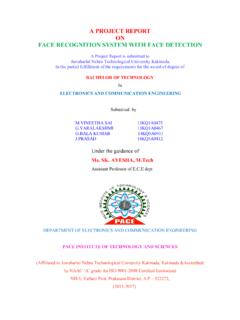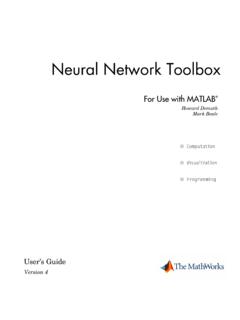Transcription of Solutions for Tutorial exercises Backpropagation neural ...
1 Solutions for Tutorial exercises Backpropagation neural networks, Na ve Bayes, Decision Trees, k-NN, Associative Classification. Exercise 1. Suppose we want to classify potential bank customers as good creditors or bad creditors for loan applications. We have a training dataset describing past customers using the following attributes: Marital status {married, single, divorced}, Gender {male, female}, Age {[ [, [ [, [ [, [65+]}, Income {[ [, [ [, [ [, [ [, [100K+]}. Design a neural network that could be trained to predict the credit rating of an applicant. Solution: We have 2 classes, good creditor and bad creditor. This means we would need two nodes in the output layer.]]]]]]]]]]]]]]
2 There are 4 variables: Marital Status, Gender, Age and Income. However, since we have 3. values for Marital status, 2 values for Gender, 4 intervals for Age and 5 intervals for Income, we would have 14 neuron units in the input layer. In the hidden layer we can have (14+2)/2=8 neurons. The architecture of the neural networks could look like this.. Married Single Divorced Male Female 18-30 30-50 50-65 65+ 10-25 25-50 50-65 65-100 100+. MaritalStatus Gender Age Income The weights are initialized with random values. Are there other possible architectures? Exercise 2. Given the following neural network with initialized weights as in the picture, explain the network architecture knowing that we are trying to distinguish between nails and screws and an example of training tupples is as follows: T1{ , , nail}, T2{ , , screw}.
3 6 7 output neurons hidden neurons 3 4 5 0 1 2 input neurons Let the learning rate be and the weights be as indicated in the figure above. Do the forward propagation of the signals in the network using T1 as input, then perform the back propagation of the error. Show the changes of the weights. Solution: What encoding of the outputs? 10 for class nail , 01 for class screw . Forward pass for T1 - calculate the outputs o6 and o7. o1= , o2= , target output 1 0, class nail . Activations of the hidden units: net3= o1 *w13+ o2*w23+b3= * + *( )+ o3=1/(1+e-net3) = net4= o1 *w14+ o2*w24+b4= *0+ * + o4=1/(1+e-net4) = net5= o1 *w15+ o2*w25+b5= * + *( )+ o5=1/(1+e-net5) = Activations of the output units: net6= o3 *w36+ o4*w46+ o5*w56 +b6= *( )+ * + * o6=1/(1+e-net6) = net7= o3 *w37+ o4*w47+ o5*w57 +b7= * + *( )+ *( )+ o7=1/(1+e-net7) = Backward pass for T1 - calculate the output errors 6 and 7.
4 (note that d6=1, d7=0 for class nail ). 6 = (d6-o6) * o6 * (1-o6)=( )* *( )= 7 = (d7-o7) * o7 * (1-o7)=( )* *( )= Calculate the new weights between the hidden and output units ( = ). w36= * 6 * o3 = * * w36new = w36old + w36 = + w37= * 7 * o3 = * * w37new = w37old + w37 = Similarly for w46new , w47new , w56new and w57new For the biases b6 and b7 (remember: biases are weights with input 1): b6= * 6 * 1 = * b6new = b6old + b6 = + Similarly for b7. Calculate the errors of the hidden units 3, 4 and 5. 3 = o3 * (1-o3) * (w36* 6 +w37 * 7 ) = *( )( * + *( ))= Similarly for 4 and 5. Calculate the new weights between the input and hidden units ( = ). w13= * 3 * o1 = *( )* w13new = w13old + w13 = Similarly for w23new , w14new , w24new , w15new and w25new; b3, b4 and b6.
5 Repeat the same procedure for the other training examples Forward pass for T2 backward pass for T2 . Exercise 3. Why is the Na ve Bayesian classification called na ve ? Answer: Na ve Bayes assumes that all attributes are: 1) equally important and 2) independent of one another given the class. Exercise 4. Na ve Bayes for data with nominal attributes Given the training data in the table below (Buy Computer data), predict the class of the following new example using Na ve Bayes classification: age<=30, income=medium, student=yes, credit-rating=fair Solution: E= age<=30, income=medium, student=yes, credit-rating=fair E1 is age<=30, E2 is income=medium, student=yes, E4 is credit-rating=fair We need to compute P(yes|E) and P(no|E) and compare them.
6 P( E1 | yes) P( E 2 | yes) P( E3 | yes) P( E 4 | yes) P( yes). P ( yes | E ) =. P( E ). P(yes)=9/14= P(no)=5/14= P(E1|yes)=2/9= P(E1|no)=3/5= P(E2|yes)=4/9= P(E2|no)=2/5= P(E3|yes)=6/9= P(E3|no)=1/5= P(E4|yes)=6/9= P(E4|no)=2/5= P ( yes | E ) = = P(no | E ) = =. P( E ) P( E ) P( E ) P( E ). Hence, the Na ve Bayes classifier predicts buys_computer=yes for the new example . Exercise 5. Applying Na ve Bayes to data with numerical attributes and using the Laplace correction (to be done at your own time, not in class). Given the training data in the table below (Tennis data with some numerical attributes), predict the class of the following new example using Na ve Bayes classification: outlook=overcast, temperature=60, humidity=62, windy=false.
7 Tip. You can use Excel or matlab for the calculations of logarithm, mean and standard deviation. matlab is installed on our undergraduate machines. The following matlab functions can be used: log2. logarithm with base 2, mean mean value, std standard deviation. Type help <function name>. ( help mean) for help on how to use the functions and examples. Solution: First, we need to calculate the mean and standard deviation values for the numerical attributes. Xi, i= the i-th measurement, n-number of measurements n X i = i =1. n n (X i )2. 2 = i =1. n 1. _temp_yes=73, _temp_yes= ; _temp_no= , _temp_no= _hum_yes= , _temp_yes= ; _hum_no= , _temp_no= Second, to calculate f(temperature=60|yes), f(temperature=60|no), f(humidity=62|yes) and f(humidity=62|no) using the probability density function for the normal distribution: (x )2.
8 1 2 2. f ( x) = e 2 . (60 73) 2.. 1 2 ( ) 2. f (temperature = 60 | yes) = e = 2 . (60 ) 2.. 1 2 82. f (temperature = 60 | no) = e = 8 2 . (62 ) 2.. 1 2 ( ) 2. f (humidity = 62 | yes) = e = 2 . (62 ) 2.. 1 2 ( ) 2. f (humidity = 62 | no) = e = 2 . Third, we can calculate the probabilities for the nominal attributes: P(yes)=9/14= P(no)=5/14= P(outlook=overcast|yes)=4/14= P(outlook=overcast|no)=0/5=0. P(windy=false|yes)=6/9= P(windy=false|no)=2/5= As P(outlook=overcast|no)=0, we need to use a Laplace estimator for the attribute outlook. We assume that the three values (sunny, overcast, rainy) are equally probable and set =3: 4 +1 5. P(outlook = overcast | yes) = = = 9 + 3 12.
9 0 +1 1. P(outlook = overcast | no) = = = 5+3 8. Fourth, we can calculate the final probabilities: * * * * *10 5. P ( yes | E ) = =. P( E ) P( E ). * * * * *10 7. P (no | E ) = =. P( E ) P( E ). Therefore, the Na ve Bayes classifier predicts play=yes for the new example . Exercise 6. Using Weka (to be done at your own time, not in class). Load iris data ( ). Choose 10-fold cross validation. Run the Na ve Bayes and Multi-layer percepton (trained with the Backpropagation algorithm) classifiers and compare their performance. Which classifier produced the most accurate classification? Which one learns faster? Exercise 7. k-Nearest neighbours Given the training data in Exercise 4 (Buy Computer data), predict the class of the following new example using k-Nearest Neighbour for k=5: age<=30, income=medium, student=yes, credit- rating=fair.
10 For similarity measure use a simple match of attribute values: Similarity(A,B)=. 4. w * (a , b ). i =1. i i i 4 where (ai , bi ) is 1 if ai equals bi and 0 otherwise. ai and bi are either age, income, student or credit_rating. Weights are all 1 except for income it is 2. Solution: RID Class Distance to New 1 No (1+0+0+1)/4= 2 No (1+0+0+0)/4= 3 Yes (0+0+0+1)/4= 4 Yes (0+2+0+1)/4= 5 Yes (0+0+1+1)/4= 6 No (0+0+1+0)/4= 7 Yes (0+0+1+0)/4= 8 No (1+2+0+1)/4=1. 9 Yes (1+0+1+1)/4= 10 Yes (0+2+1+1)/4=1. 11 Yes (1+2+1+0)/4=1. 12 Yes (0+2+0+0)/4= 13 Yes (0+0+1+1)/4= 14 No (0+2+0+0)/4= Among the five nearest neighbours four are from class Yes and one from class No. Hence, the k-NN.


